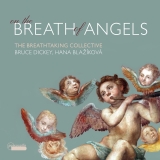 On the Breath of Angels; Giovanni Maria Bononcini: Il Trionfo di Camilla-Sinfonia + Se Ninfa o Dea tu sei: E' pur ver ch'a soffrir + Tutte armate + Sonate op. 6 Nr. 5; Francesco Cavalli: Sonata a tres; O quam suavis; Ivan Moody: O Archangels and Angels; Carlo G.: Panis angelicus + Sicut sponsus matris + Mater Hierusalem; Sigismondo d'India: Videte miraculum; Giovanni Pierluigi da Palestrina: Angelus Domini; Erik Satie: Les Anges; Alessandro Scarlatti: Coronata di lauri + Cara e dolce rimembranza + Il desio di vendicarmi; Julian Wachner: The Vision of the Archangels; Hana Blazikova, Sopran, Bruce Dickey, Cornetto, The Breathtaking Collective; 1 CD Passacaille 1091; Aufnahme 02/2020, Veröffentlichung 02/2021 (72'35) – Rezension von Uwe Krusch
On the Breath of Angels; Giovanni Maria Bononcini: Il Trionfo di Camilla-Sinfonia + Se Ninfa o Dea tu sei: E' pur ver ch'a soffrir + Tutte armate + Sonate op. 6 Nr. 5; Francesco Cavalli: Sonata a tres; O quam suavis; Ivan Moody: O Archangels and Angels; Carlo G.: Panis angelicus + Sicut sponsus matris + Mater Hierusalem; Sigismondo d'India: Videte miraculum; Giovanni Pierluigi da Palestrina: Angelus Domini; Erik Satie: Les Anges; Alessandro Scarlatti: Coronata di lauri + Cara e dolce rimembranza + Il desio di vendicarmi; Julian Wachner: The Vision of the Archangels; Hana Blazikova, Sopran, Bruce Dickey, Cornetto, The Breathtaking Collective; 1 CD Passacaille 1091; Aufnahme 02/2020, Veröffentlichung 02/2021 (72'35) – Rezension von Uwe Krusch

Engel, die singen oder ein Musikinstrument spielen, wurden vom 16. bis ins 18. Jahrhundert häufig dargestellt. Eines der oft zu sehenden Instrumente ist der Zink. Dieses mit einem Kesselmundstück wie die Trompete angeblasene Instrument zählt damit zu den Blechbläsern. Die Idee der Einspielung kreist auch darum, die Ähnlichkeiten zwischen dem Klang dem Zink und der menschlichen Stimme darzustellen. Neben ausdrücklich für diese Kombination geschriebenen Stücken sind es solche, in denen der Zink die zweite Singstimme oder die der Violine ersetzt.
Ergänzend dazu haben die Interpreten zeitgenössische Werke für diese Besetzung an Ivan Moody und Julian Wachner in Auftrag gegeben, die ihren Platz eingereiht in dem Programm finden. Und Les Anges von Erik Satie wurde ebenfalls, hier für Stimme und Theorbe, eingewoben. So hatten sie es auch schon bei ihrer früheren CD in dieser Besetzung gemacht. Einige Werke, die einen Carlo G als Komponisten ausweisen, stammen aus einer auf einem Flohmarkt entdeckten Sammlung mit Monodien und Duetten. Der Komponist lässt sich schlichtweg wegen eines Flecks auf dem Namen nicht mehr nachvollziehen. Denkbar wäre, da sich im Text noch eine Initiale findet, der mit Rom verbundene Name Graziani.
Atemberaubend an dieser CD ist nicht allein der Name des Ensembles, sondern das sensibel aktive und so gelungene Zusammenspiel der Beteiligten. Wenn die Sopranistin Hana Blazikova und der Cornettist Bruce Dickey herausgehoben erscheinen, so ist das zwar einerseits wegen ihrer besonderen Rollen richtig. Aber eigentlich steht das dem geschlossenen Ensembleauftritt, der ganz auf Gemeinsamkeit ausgerichtet ist, entgegen. In der kleinen Besetzung mit maximal acht Beteiligten ist jeder solistisch unterwegs und dementsprechend aktiv in der Darbietung seiner Stimme. Dabei halten sie aber Maß und sind einfach fokussiert und inspiriert, aber nicht aufreizend übertrieben engagiert. Jeder bringt sich gewinnbringend ein, aber keiner versucht, die anderen zu übertrumpfen. So gelingt eine äußerst musikalische Nähe, in der sich Stimme und Zink mit Kapriolen und Girlanden umgarnen und beflügeln. Aber auch dabei steht die gezielte Umsetzung der Affekte der Musik im Zentrum, nicht die Selbstdarstellung. Die klangliche Verwandtschaft des Zinks zur menschlichen Stimme erkennt man auch in den neu geschaffenen Werken. So lässt man sich gerne anhauchen.
Angels singing or playing a musical instrument were frequently depicted from the 16th to the 18th century. One of the instruments often seen is the cornet. This instrument, blown with a cup mouthpiece like the trumpet, thus belongs to the brass instruments. The idea also was to show the similarities between the sound of the cornet and the human voice. In addition to pieces written expressly for this combination, there are those in which the cornet replaces the second singing voice or that of the violin.
On top, the performers have commissioned contemporary works for this instrumentation from Ivan Moody and Julian Wachner, which find their place in the programme. And ‘Les Anges’ by Erik Satie was also woven in, here for voice and theorbo. They had done the same on their earlier CD with this instrumentation. Some of the works are written by a certain Carlo G. They come from a collection of monodies and duets discovered at a flea market. The composer can simply no longer be traced because of a blot on the name. Conceivable, since there is still an initial in the text, would be the name Graziani, associated with Rome.
What is breathtaking about this CD is not only the name of the ensemble, but the sensitively active and so successful interplay of the participants. If the soprano Hana Blazikova and the cornettist Bruce Dickey appear to be singled out, this is true on the one hand because of their special roles. But actually this is contrary to the cohesive ensemble performance, which is entirely oriented towards togetherness. In the small cast with a maximum of eight participants, everyone is a soloist and accordingly active in the performance of his or her part. Yet they keep a moderate pace and are simply focused and inspired, but not tantalisingly over-committed. Everyone contributes profitably, but no one tries to outdo the others. In this way, an extremely musical closeness succeeds, in which voice and cornet ensnare and inspire each other with capers and garlands. But here, too, the focus is on the targeted realization of the music’s affects, not on self-expression. The tonal relationship of the cornet to the human voice is also recognizable in the newly created works. This is how one likes to let oneself be breathed on.
























